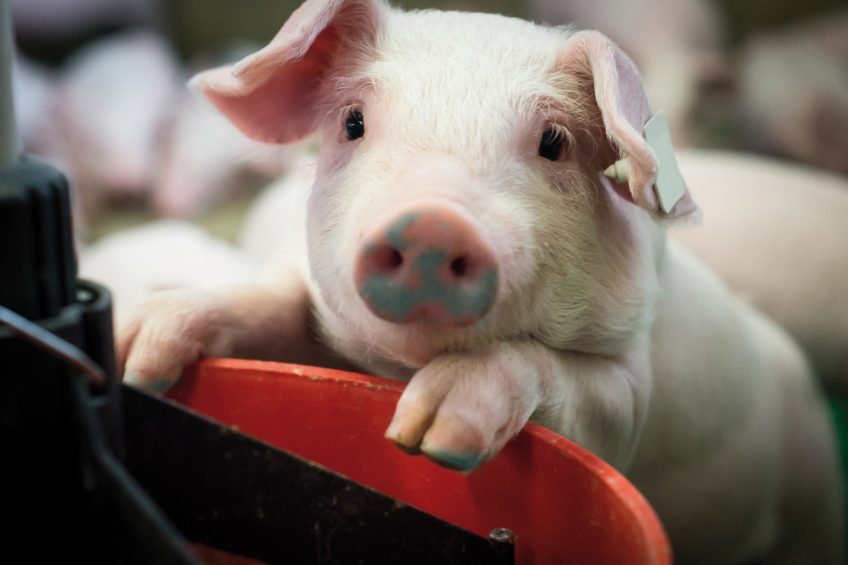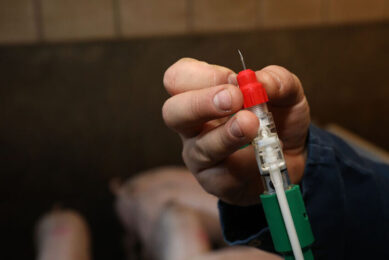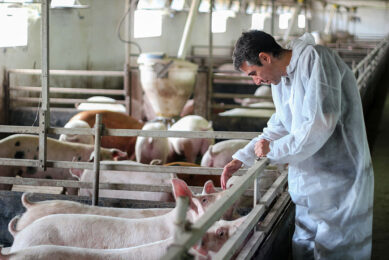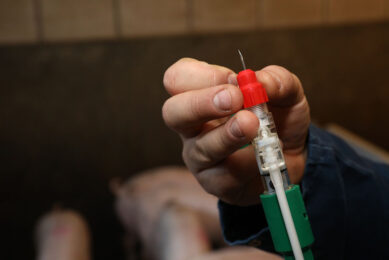Vaccination against ileitis via liquid feed

Adding a vaccine to liquid feed – until recently this was an uncommon approach in the European Union. It has become possible for vaccination against ileitis. How does that work in practice?
Due to the rising public pressure on the use of antibiotics in food producing animals, the demand for alternative methods to control bacterial diseases in pigs has increased. Oral live vaccination has proven to be a successful and sustainable tool in controlling ileitis, globally the most common enteric disease in pigs. While pigs can be vaccinated individually by drench, until now most pigs were conveniently vaccinated via drinking water. However, on farms using liquid feeding systems, water uptake through the water line is not reliable as the water demand is mainly fulfilled by the liquid feed. Therefore vaccination via drinking water is not possible and applying the vaccine via the liquid feed system is the only option for mass vaccination.
Basic principles similar to drinking water administration
Basically the same principles apply as for vaccination via the drinking water. The feeding system needs to be clean, and should not contain any residues of antimicrobials, detergents or disinfectants. As Enterisol Ileitis, manufactured by Boehringer Ingelheim Animal Health, is an oral vaccine containing live attenuated Lawsonia, no antibiotics effective against those bacteria should be used for three days before, on the day and three days after vaccination.
Liquid feed systems differ between farms so do the details of the administration process, but the principles are the same across farms. On the day before vaccination the groups to be vaccinated should be determined and it should be checked if the liquid feeding system works properly. To ensure that every pig receives a sufficient amount of vaccine, the vaccine should be applied in at least 30% of the daily feed ration. Only fresh drinking water should be used for liquid feed preparation, as carry-over of disinfectants or other harmful substances might occur via used water.
It is recommended to add thiosulfate blue to the liquid feed. Thiosulphate will neutralise chlorine contained in the drinking water, in addition, the blue colour will help to check that the feed containing vaccine reaches the right pigs. One dose of vaccine is reconstituted per pig to be vaccinated. Reconstituted vaccine should be mixed with the liquid feed immediately and for a long enough time to ensure homogenous distribution.
Usually the vaccine is applied in the second feeding block of the day. With sensor feeding all meals in a feeding block should contain vaccine. For vaccination, troughs need to be really empty and pigs should take up feed quickly, but not in a rush. To ensure this, it can be useful to reduce the amount of feed in the block ahead of vaccination or to postpone feeding for some time. Often, farmers are very familiar with their own liquid feeding system and feel confident as they routinely use it day by day, so they know best how to adapt those principles to their system.

Frequently asked questions from the field
Vaccination via liquid feed had already been practiced successfully for several years. However, certain questions were frequently asked by veterinarians and producers. To answer those questions and to achieve a label claim for liquid feed vaccination, several studies were conducted.
Vaccine stability was tested and demonstrated over four hours at room temperature with various types of commercial feed suitable for different age groups (mixed 1:3 with water). Diets contained levels of copper up to 150 mg/kg and levels of zinc up to 170 mg/kg. All four feed types contained a mixture of formic and propionic acid, in addition finisher feeds contained benzoic acid. For details of feed composition, see Table 1.
Further testing showed that the vaccine is stable when lactobacilli and yeast are present in the feed. Using acidified water it was demonstrated that pH levels as low as 2.5 do not harm the vaccine. Finally, it could be shown that the vaccine is evenly distributed in the fluid phase of the liquid feed. Based on the positive experience with vaccination via liquid feed, the European authorities recently granted the oral live ileitis vaccine, manufactured by Boehringer Ingelheim, a label claim for the administration via liquid feed.
A case study from the Netherlands
The Drenthehoeve, located in Geesbrug, close to Hoogeveen in the Netherlands, is using a sensor liquid feeding system for its 12,000 finishing places. The system was installed in 2011, when the trading firm Handelshuis Schuttert took over the farm. The ability to vary the use of by-products is a major advantage of a liquid feed system, especially on a farm with as many animals as the Drenthehoeve farm.
The changing feed composition, however, using up to ten by-products put pressure on the animals’ gut health and ileitis kept rearing its ugly head. In consultation with his veterinary surgeon, Rick Janssen, from the specialist pig practice De Varkenspraktijk, farm manager Erwin Kelder decided to feed a slightly more expensive diet and start in-feed vaccination with the vaccine. Experiences have been positive so far, with no ileitis problems for the last 18 months.
Mr Kelder now vaccinates three different week groups of around 2,000 finishers once every three weeks. The animals receive four meals containing the vaccine. Two days before, Mr Kelder starts to pay extra attention to the animals’ feed intake. He tailors the ration accordingly; to make sure every animal receives enough vaccine. Even in the larger groups, this vaccination method appears to work well.
Vaccination soon had an effect on the technical results. Over the course of a year, the corrected average daily weight gain rose from 724 to 816 g. Mortality fell from 4 to 1.9%, and the feed conversion ratio from 2.54 to 2.38. Besides improving the results, vaccination increased job satisfaction on the farm. Batches are more uniform and the pens are emptied a week sooner. These results were maintained over the past year. For Mr Kelder, that proved to be a sign that ileitis is under control and gut health is stable.
Like everything else at the Drenthehoeve, vaccination against ileitis is on the table regularly, but the farm will continue to vaccinate. A stable gut health is very valuable as it does not only improve technical results but leads to a better throughput of animals thus giving job satisfaction every day. Vaccination will not eliminate Lawsonia from a farm; therefore stopping vaccination is not an option as disease would come back sooner or later.
References are available on request.
 Beheer
Beheer








 WP Admin
WP Admin  Bewerk bericht
Bewerk bericht